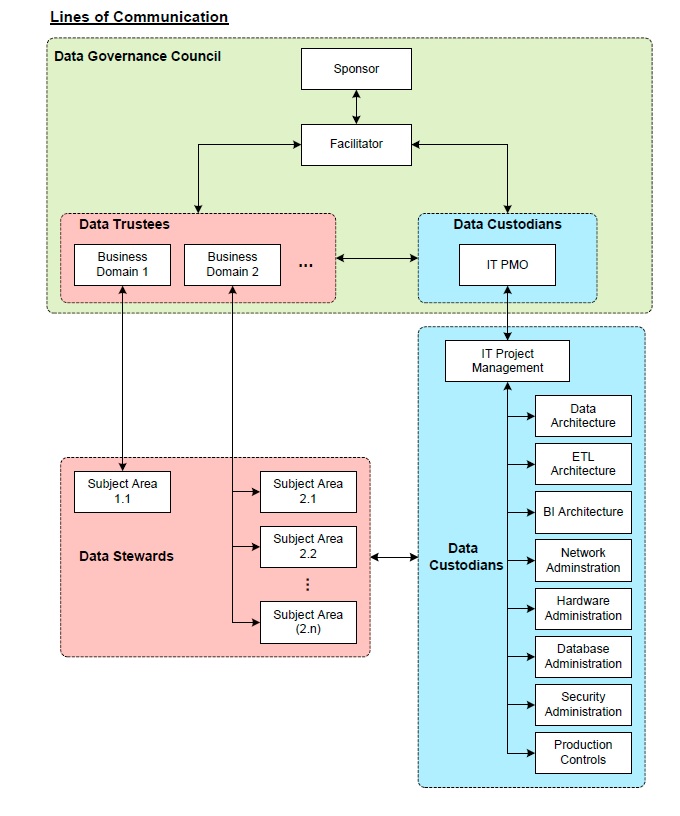
EDM Stakeholders
Data Governance Overview
represents the active and ongoing shared responsibility between the data trustees and stewards, who are the "business" owners of the enterprise data assets; and the IT data management professionals, who are the expert "technical" custodians of the enterprise data assets.
Utilizing this "collaborative approach" will assure quality decision-making associated with the planning and execution of standards, policies, processes, procedures, and projects that acquire, control, protect, deliver, and enhance the value of mission-critical enterprise data assets owned by Creighton University.
The Data Governance "hierarchy" adopted by Creighton University consists of the following roles:
1) EDM Sponsor
The EDM Sponsor (i.e. President) is the individual who has the authority to fund and drive the university’s strategic initiative to implement an EDM program. The EDM Sponsor appoints the members of the EDM Council.
2) EDM Facilitator (Product Manager)
The EDM Facilitator is a member of the EDM Council and serves as the EDM product manager; and liaison between the EDM Sponsor, EDM Council, and the EDM Data Custodians. Ideally this role is played by an individual with a blend of talent spanning higher-education, product management, program management, risk management, business intelligence, and data technologies.
3) EDM Council
The EDM Council will leverage the existing "strategic" decision-making structure (i.e. President’s Cabinet) at Creighton to facilitate the strategic planning and product strategy associated with Enterprise Data Management. The enterprise data is classified according to the existing business domains such as Academic Affairs, Student Life, Health Sciences, Operations, Finance, and Human Resources.
In most cases, EDM Council member’s represent one-or-more "business domains", where they assume the highest-level of accountability, as the EDM Data Trustees.
The roles, responsibilities, lines-of-communication, and deliverables of the EDM Council can be found in the Council Charter; and assigned EDM Council members can be found in the Data Governance Matrix.
4) EDM Data Stewards
Each business domain can be further divided into "subject areas", where one-or- more EDM Data Steward’s, who are considered to be subject-matter experts, can be assigned by the EDM Data Trustee that owns the business domain. Examples of subject areas within a business domain such as Academic Affairs might include: Academic Excellence and Assessment, Enrollment Management, Student Retention, and Faculty Development.
The roles, responsibilities, lines-of-communication, and deliverables of the EDM Stewards can be found in the Data Steward Charter; and assigned EDM Data Steward members can be found in the Data Governance Matrix.
5) EDM Data Custodians
The EDM Data Custodians represent the Information Technology professionals, who are the "technical" custodians of the enterprise data assets. This includes: Program/Project Management (i.e. Release Management); Data Architecture; ETL Architecture; BI Architecture; Network Administration; Hardware Administration; Database Administration; and Security Administration.
The roles, responsibilities, lines-of-communication, and deliverables of the EDM Data Custodians can be found in the Data Custodian Charter; and specific Data
Custodian assignments (i.e. Program/Project Manager, Data Architect, BI Architect, and Security Administrator) can be found in the Data Governance Matrix
Important Notes:
An EDM Stakeholder can play more than one role, based on the potential efficiencies gained within the university’s organizational structure. For example, a Business Domain might only have one Subject Area, so the same person can play both the role of the Council member and the EDM Data Steward.
The EDM Business Domain and EDM Subject Area roles are the trustees and stewards of the enterprise data, and are therefore are both accountable for the quality and security of the data.


 2500 California Plaza
2500 California Plaza



